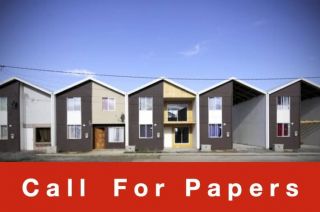
www.buildingsandcities.org/calls-for-papers/alternatives-air-conditioning.html
Alternatives to Air Conditioning: Policies, Design, Technologies, Behaviours

Guest Editors: Brian Ford (Nottingham U), Dejan Mumovic (UCL), Rajan Rawal (CEPT University)
Abstract submissions closed on 12 APRIL 2021
Can our cities and buildings be designed to have little or no mechanical intervention?
The alternatives to conventional air conditioning embrace much more than a technological issue - they require holistic design thinking and include social aspects (expectations, behaviours, practices) which may challenge the ways in which work, leisure and other activities are pursued. This special issue explores alternative approaches to providing thermal comfort and ventilation in different climatic zones across the world at the scales of building, neighbourhood and city. It considers the implications of these alternatives across a range of issues: health, wellbeing, air quality and heat stress; technical / design solutions; social expectations and practices; climate change; policy and regulation; supply chain and procurement; education and training. It includes a range of disciplines: geography, sociology, anthropology, behavioural sciences, architecture, engineering, public health, economics, energy and environmental assessment.
In urbanised areas, there is an opportunity to break the current dependency on air conditioning. The design of cities, neighbourhoods and buildings can ensure ventilation and thermal comfort by climate friendly means. Retrofit opportunities for the existing building stock can make existing buildings comfortable without increasing energy demand. The design of new buildings and their environs can reduce or eliminate the need for air conditioning.
Equally important are the responses of the many different actors that promote or inhibit adoption - policy makers, clients, construction professions and the supply chain (development and procurement). Key questions include:
- What constitutes a national cooling action plan?
- How resilient should buildings and cities be to a warmer world?
- How resilient to heat should buildings be if energy supply is disrupted?
- What role do design and construcion professionals and the supply chain have in implementing change?
Last year China and India introduced national cooling action plans, and France committed to the 'Biarritz Pledge' for fast action on efficient cooling. In 2019 the Global Cool Cities Alliance also issued their 'Million cool roofs challenge'. City scale action plans are vital. Ahmedabad published its first heat action plan in 2013 and there is now evidence that it is beginning to save lives among those who are most vulnerable. The Kigali Cooling Efficiency Program (K-CEP) is another example of energy-efficient, climate-friendly, and affordable cooling solutions to refrigeration and cooling.
Background: why are alternatives needed?
- Health and wellbeing. (not only Covid-19 and potential future pandemics) Re-circulation of untreared air may no longer be acceptable. The linkages between ventilation (100% fresh air) and health are increasingly identified as important. The pattern of air movement may be significant.
- Physiological need for thermal variation and ventilation.
- Adaptive measures to maintain thermal comfort.
- Energy demand and negative environmental impacts of refrigerants, waste heat, materials, etc (projected energy demand from a/c is not sustainable - new peak demands)
- Economics and equity (poorest people are made vulnerable)
- Changing social expectations and rapid urbanisation (increased demand)
- A changing climate (hotter - humid and/or more extreme)
Possible topics
Urban design issues - planning (building height, configuration, materials, external shading, over-shadowing, urban heat island, vegetation and open spaces, etc), effects on ventilation and cooling
Neighbourhood design - particularly microclimates (scale, shading, air movement, open space, trees and vegetation, urban 'oases').
Building design - spatial configurations of buildings to help achieve comfort, the performance and outcomes of new build and retrofit across a range of building types and technologies (see below), their design integration aspects, their impact on building morphologies, occupant agency (see below) and feedback. Reduction of loads e.g. shading, buffer zones, orientation, optimal window opening sizes, etc), advanced natural ventilation, wind tower systems, etc. Building materials and techniques.
Social behaviours & Inhabitant agency - how people actually inhabit buildings and cities. Patterns of occupation and practices inside and outside buildings include seasonal and diurnal adaptation which impact the need for cooling (e.g. the traditional siesta), communication of appropriate information on how to operate the building.
Cooling technologies and their application - examination different technologies (performance, economics, whole life impacts, etc) and their integration: natural ventilation, evaporative cooling, radiant cooling, night time cooling , ice cooling, ground water cooling, thermal mass and cooling, negawatt cooling.
Demographics - analysis increasing demand for air conditioning due to affluence, disparities within countries of a/c unit ownership, people adversely affected / made vulnerable now or in future climate scenarios.
Economics - macro analysis of different thermal comfort scenarios (capital and operating costs vs societal costs e.g. health, environmental, social impacts).
Policy, regulation & standards - what shifts & incentives are needed at individual building, neighbourhood and city scales to encourage buildings without mechanical systems, to create appropriate internal temperature targets, to protect the "commons" (e.g. eliminate waste heat from a/c), to provide planning for appropriate shading, ventilation, green infrastructure at neighbourhood & city scales.
Public health - comparison of mechanical vs non-mechanical ventilation: airborne infectious transmission rates, air movement patterns in rooms and buildings, CO2 concentration & air pollutants, the physiology of adaptive comfort, the influence of neighbourhood microclimate and the incidence/transmission of infectious disease
Energy use and environment impacts - impacts of a/c on energy demand, peak energy and GHG emissions.
Public attitudes - the anthropology of cooling, the current and changing expectations for cooling: thermal pleasure, cooling desire, air conditioning and 'development', public attitudes to cooling in warm places
Market transformation - analysis of current and alternative development & procurement models. Standard models reward developers for creating a/c buildings. What new models are needed for rewarding low energy alternatives, e.g cooling as a service (CAAS)? The business case for alternative approaches.
Education & training - What are the roles of individual teachers / staff in leading change? What resistance and difficulties do they meet? How can educators overcome these barriers?
Certification - are different / alternative processes of certification required for alternative cooling systems? Do professionals and vocational workers need different / additional / alternative qualifications to show they have appropriate skills?
Briefing Note for Contributors
You are invited to submit an abstract for a journal paper in this special issue of Buildings & Cities. In the first instance, please send a 500 word (maximum) abstract defining the scope, methods and results to Richard Lorch richard@rlorch.net by MONDAY 12 APRIL 2021. The initial abstract submission must include:
- the author's and all co-author's names, affiliations and contact details
- the question(s) and topics in this Call for Papers that the abstract and intended paper addresses
- the abstract (300 - 500 words maximum) which should include a description of methods and key findings
Abstracts will be reviewed by the editors to ensure a varied, yet integrated selection of papers around the topic of the special issue. Authors of accepted abstracts will be invited to submit a full paper which then undergoes a double-blind peer review process.
The journal publishes the several different types of papers: research, synthesis, policy analysis, methods, & replication. Details on their scope and length: https://www.buildingsandcities.org/about/aims-and-scope.html
Timeline
Deadline for abstract submission: 12 April 2021
Full papers due: 01 September 2021
Referees' comments: 01 December 2021
Final version due: 01 February 2022
Publication: April 2022
Note: papers are published as soon as they are accepted and therefore some papers will progress faster and appear in advance of the whole issue.
Buildings & Cities
Buildings & Cities is an international, open access, not-for-profit, double-blind peer-reviewed research journal. Its focus is the interactions between buildings, neighbourhoods and cities by understanding their supporting social, economic and environmental systems. More information including its Aims & Scope, Key Principles and Editorial Board can be found online: www.buildingsandcities.org. Buildings & Cities is an open access journal and has an article processing charge of £1200 (for research, synthesis and methods papers) and £1100 (for policy analysis and replication papers). If you do not have institutional support, please contact the editor-in-chief to discuss. We endeavour to assist those without funding to publish in our journal.
Questions?
If you have a question, please contact: Richard Lorch richard@rlorch.net (editor in chief), Brian Ford brian@naturalcooling.co.uk, Dejan Mumovic d.mumovic@ucl.ac.uk, Rajan Rawal rajanrawal@cept.ac.in
Further reading
Aram, F., Higueras García, E., Solgi, E. & Mansournia, S. (2019). Urban green space cooling effect in cities. Heliyon 5.
Brager, G., Zhang, H. & Arens, E. (2015) Evolving opportunities for providing thermal comfort. Building Research & Information, 43(3) 274-287.
Cole, R. J., Robinson, J., Brown, Z., & O'Shea, M. (2008). Re-contextualizing the notion of comfort. Building Research & Information, 36(4), 323-336.
Davis, L. W. & Gertler, P. J. (2015). Contribution of air conditioning adoption to future energy use under global warming. Proc. Natl Acad. Sci. USA 112, 5962-5967. https://www.pnas.org/content/112/19/5962
Ford, B., Schiano-Phan, R. & Vallejo, J.A. (2020) The Architecture of Natural Cooling (2nd edition). Abingdon: Routledge.
IEA. (2018). The future of cooling: opportunities for energy efficient air conditioning. Paris: International Energy Agency.
IEA. (2020). Progress Report on Cooling. Paris: International Energy Agency. https://www.iea.org/reports/cooling
Infante Ferreira, C. & Kim, D.S. (2014). Techno-economic review of solar cooling technologies based on location-specific data. International Journal of Refrigeration, 39, 23-37.
Khosla, R., Miranda, N.D., Trotter, P.A. et al. (2020). Cooling for sustainable development. Nature Sustainability https://doi.org/10.1038/s41893-020-00627-w
Kigali Cooling Efficiency Program - K-CEP(2018). Cooling as a Service (CaaS) https://www.k-cep.org/wp-content/uploads/2018/07/Cooling-as-a-service-Knowledge-brief-6.7.2018_Final_online_v1.pdf
Passe, U. & Battaglia, F. (2015). Designing Spaces for Natural Ventilation: An Architect's Guide. New York: Routledge.
Samuel, D.G.L., Nagendra, S.M.S. & Maiya (2013). Passive alternatives to mechanical air conditioning of building: a review. Building and Environment, 66, 54-64.
Short, C.A. (2017). The Recovery of Natural Environments in Architecture: Air, Comfort and Climate. Abingdon: Routledge.
Shove, E. (2018). What is wrong with energy efficiency? Building Research & Information, 46(7), 779-789.
Ürge-Vorsatz, D., Cabeza, L. F., Serrano, S., Barreneche, C. & Petrichenko, K. (2015). Heating and cooling energy trends and drivers in buildings. Renewable Sustainable Energy Review, 41, 85-98. https://www.sciencedirect.com/science/article/pii/S1364032114007151
Watts, N. et al. (2020). The 2020 report of The Lancet Countdown on health and climate change: responding to converging crises. Lancet. 396. DOI:>https://doi.org/10.1016/S0140-6736(20)32290-X
Latest Peer-Reviewed Journal Content
A living lab approach to co-designing climate adaptation strategies
M K Barati & S Bankaru-Swamy
Mediation roles and ecologies within resilience-focused urban living labs
N Antaki, D Petrescu, M Schalk, E Brandao, D Calciu & V Marin
Negotiating expertise in Nepal’s post-earthquake disaster reconstruction
K Rankin, M Suji, B Pandey, J Baniya, D V Hirslund, B Limbu, N Rawal & S Shneiderman
Designing for pro-environmental behaviour change: the aspiration–reality gap
J Simpson & J Uttley
Lifetimes of demolished buildings in US and European cities
J Berglund-Brown, I Dobie, J Hewitt, C De Wolf & J Ochsendorf
Expanding the framework of urban living labs using grassroots methods
T Ahmed, I Delsante & L Migliavacca
Youth engagement in urban living labs: tools, methods and pedagogies
N Charalambous, C Panayi, C Mady, T Augustinčić & D Berc
Co-creating urban transformation: a stakeholder analysis for Germany’s heat transition
P Heger, C Bieber, M Hendawy & A Shooshtari
Placemaking living lab: creating resilient social and spatial infrastructures
M Dodd, N Madabhushi & R Lees
Church pipe organs: historical tuning records as indoor environmental evidence
B Bingley, A Knight & Y Xing
A framework for 1.5°C-aligned GHG budgets in architecture
G Betti, I Spaar, D Bachmann, A Jerosch-Herold, E Kühner, R Yang, K Avhad & S Sinning
Net zero retrofit of the building stock [editorial]
D Godoy-Shimizu & P Steadman
Co-learning in living labs: nurturing civic agency and resilience
A Belfield
The importance of multi-roles and code-switching in living labs
H Noller & A Tarik
Researchers’ shifting roles in living labs for knowledge co-production
C-C Dobre & G Faldi
Increasing civic resilience in urban living labs: city authorities’ roles
E Alatalo, M Laine & M Kyrönviita
Co-curation as civic practice in community engagement
Z Li, M Sunikka-Blank, R Purohit & F Samuel
Preserving buildings: emission reductions from circular economy strategies in Austria
N Alaux, V Kulmer, J Vogel & A Passer
Urban living labs: relationality between institutions and local circularity
P Palo, M Adelfio, J Lundin & E Brandão
Living labs: epistemic modelling, temporariness and land value
J Clossick, T Khonsari & U Steven
Co-creating interventions to prevent mosquito-borne disease transmission in hospitals
O Sloan Wood, E Lupenza, D M Agnello, J B Knudsen, M Msellem, K L Schiøler & F Saleh
Circularity at the neighbourhood scale: co-creative living lab lessons
J Honsa, A Versele, T Van de Kerckhove & C Piccardo
Positive energy districts and energy communities: how living labs create value
E Malakhatka, O Shafqat, A Sandoff & L Thuvander
Built environment governance and professionalism: the end of laissez-faire (again)
S Foxell
Co-creating justice in housing energy transitions through energy living labs
D Ricci, C Leiwakabessy, S van Wieringen, P de Koning & T Konstantinou
HVAC characterisation of existing Canadian buildings for decarbonisation retrofit identification
J Adebisi & J J McArthur
Simulation and the building performance gap [editorial]
M Donn
Developing criteria for effective building-sector commitments in nationally determined contributions
P Graham, K McFarlane & M Taheri
Join Our Community

The most important part of any journal is our people – readers, authors, reviewers, editorial board members and editors. You are cordially invited to join our community by joining our mailing list. We send out occasional emails about the journal – calls for papers, special issues, events and more.
We will not share your email with third parties. Read more



Latest Commentaries
COP30 Report
Matti Kuittinen (Aalto University) reflects on his experience of attending the 2025 UN Conference of the Parties in Belém, Brazil. The roadmaps and commitments failed to deliver the objectives of the 2025 Paris Agreement. However, 2 countries - Japan and Senegal - announced they are creating roadmaps to decarbonise their buildings. An international group of government ministers put housing on the agenda - specifying the need for reduced carbon and energy use along with affordability, quality and climate resilience.
Building-Related Research: New Context, New Challenges
Raymond J. Cole (University of British Columbia) reflects on the key challenges raised in the 34 commissioned essays for Buildings & Cities 5th anniversary. Not only are key research issues identified, but the consequences of changing contexts for conducting research and tailoring its influence on society are highlighted as key areas of action.